Tiny homes are gaining popularity, but many misconceptions surround them. Discover the truth behind five huge lies that could impact your tiny living journey.
Understanding Tiny Homes
Tiny homes are defined as dwellings that typically measure less than 400 square feet. This minimalist approach to living has gained traction in recent years, appealing to those seeking a simpler lifestyle.
Many people are drawn to tiny homes due to their affordability and sustainability. However, the reality of tiny living can often be misrepresented.
In this section, we will explore what constitutes a tiny home and the various styles available, from mobile tiny houses to stationary models.
Understanding the nuances of tiny homes can help potential buyers make informed decisions about their living arrangements.
Myth 1: Tiny Homes Are Only for Minimalists

Debunking the Minimalist Stereotype
One of the most pervasive myths is that tiny homes are exclusively for minimalists. While minimalism is a key aspect for many tiny home dwellers, it is not a prerequisite.
People from various backgrounds and lifestyles choose tiny homes for different reasons, including financial freedom, environmental concerns, or simply a desire for less clutter.
This myth can deter potential buyers who may feel they don’t fit the minimalist mold, but tiny homes can be customized to reflect personal tastes and needs.
Ultimately, tiny living can accommodate a wide range of lifestyles, proving that it’s not just for those who embrace minimalism.
Customizing Your Tiny Home
Customization is a significant advantage of tiny homes. Owners can design their spaces to reflect their unique personalities and preferences.
From choosing colors and materials to selecting furniture and decor, tiny homes can be tailored to suit individual tastes.
This flexibility allows for a more personalized living experience, making tiny homes appealing to a broader audience.
In fact, many tiny home owners incorporate elements from their previous larger homes, creating a blend of styles that feels comfortable and familiar.
Myth 2: Tiny Homes Are Not Practical for Families
Family-Friendly Tiny Living
Another common misconception is that tiny homes are unsuitable for families. While space is limited, many families have successfully adapted to tiny living.
Designing a functional layout is crucial for families considering a tiny home. Multi-functional furniture, clever storage solutions, and open floor plans can make tiny homes work for families.
Some tiny homes are built specifically for family living, featuring lofted sleeping areas and spacious communal spaces.
Families can enjoy the benefits of tiny living, such as reduced expenses and a closer family bond, despite the smaller square footage.
Real-Life Family Examples
Numerous families have shared their experiences living in tiny homes, highlighting how they manage space and maintain comfort.
For instance, some families have opted for tiny homes on wheels, allowing them to travel while still having a stable home base.
Others have embraced community living, where multiple tiny homes are situated close together, fostering a sense of neighborhood and support.
These examples demonstrate that tiny homes can indeed be practical and enjoyable for families of all sizes.
Myth 3: Tiny Homes Are Always Cheaper
The Cost of Tiny Living
While tiny homes are often marketed as a more affordable housing option, this is not always the case. The initial cost can vary significantly based on materials, design, and location.
Many tiny homes are custom-built, which can drive up costs beyond what some traditional homes might be priced at.
Additionally, land prices can be a significant factor. In some areas, finding affordable land to place a tiny home can be challenging.
Potential buyers should conduct thorough research and budgeting before committing to a tiny home purchase.
Hidden Costs of Tiny Homes
Beyond the initial purchase price, there are often hidden costs associated with tiny living. Utility connections, permits, and maintenance can add up quickly.
Furthermore, some tiny home owners may need to invest in additional storage solutions or off-site storage, which can further increase expenses.
Understanding the total cost of ownership is essential for anyone considering a tiny home, ensuring that they are prepared for the financial commitment.
By being aware of these potential costs, buyers can make more informed decisions and avoid financial pitfalls.
Myth 4: Tiny Homes Are Not Energy Efficient
Energy Efficiency in Tiny Homes
Contrary to popular belief, tiny homes can be incredibly energy efficient. Their smaller size often means lower energy consumption compared to traditional homes.
Many tiny homes are built with sustainable materials and equipped with energy-efficient appliances, further reducing their environmental impact.
Solar panels are also a popular addition, allowing tiny home owners to generate their own electricity and decrease reliance on the grid.
This eco-friendly approach appeals to many individuals looking to minimize their carbon footprint while enjoying the benefits of tiny living.
Innovative Energy Solutions
Innovative technologies are making tiny homes even more energy efficient. From advanced insulation techniques to smart home systems, the possibilities are endless.
These technologies can help regulate temperature, manage energy use, and even automate tasks, making tiny living more convenient and sustainable.
By embracing these innovations, tiny home owners can enjoy a comfortable living environment while being mindful of their energy consumption.
As awareness of energy efficiency grows, more tiny home builders are incorporating these features into their designs, making tiny living an attractive option for eco-conscious individuals.
- Use multi-functional furniture that serves more than one purpose, such as a sofa bed or a table that can be folded away when not in use.
- Incorporate vertical storage solutions, such as shelves that reach the ceiling or wall-mounted organizers, to keep the floor area open.
- Utilize under-bed storage or built-in furniture that includes hidden compartments for additional storage options.
- Consider an open floor plan that minimizes walls and barriers, creating a sense of spaciousness.
- Invest in custom cabinetry that fits the specific dimensions of your space, allowing for efficient use of every inch.
- Inspecting the roof and gutters at least twice a year to prevent water damage.
- Checking for leaks in plumbing and ensuring proper drainage to avoid water-related issues.
- Cleaning and servicing appliances regularly to maintain efficiency and longevity.
- Updating any weatherproofing materials to ensure energy efficiency is maintained.
Frequently Asked Questions (FAQ)
Are tiny homes too small for families?
Many believe tiny homes are unsuitable for families, but they can be designed to accommodate multiple occupants. With smart storage solutions and multifunctional spaces, families can thrive in tiny homes, fostering closeness and reducing clutter.
Do tiny homes lack modern amenities?
Contrary to popular belief, many tiny homes are equipped with modern amenities. Homeowners often include full kitchens, bathrooms, and energy-efficient appliances, making tiny living both comfortable and convenient without sacrificing quality.
Is living in a tiny home always cheaper?
While tiny homes can reduce housing costs, expenses vary based on location, materials, and design choices. Some tiny homes can be quite expensive, especially if custom-built. It’s essential to budget carefully to ensure affordability.
Are tiny homes difficult to finance?
Financing tiny homes can be challenging, as traditional mortgages may not apply. However, options like personal loans, RV loans, or specialized tiny home lenders exist. Researching financing options can help potential buyers find suitable solutions.
Do tiny homes have resale value?
Resale value for tiny homes can be unpredictable, influenced by location and market demand. While some tiny homes appreciate, others may depreciate. It’s vital to consider the long-term investment potential before purchasing a tiny home.





















